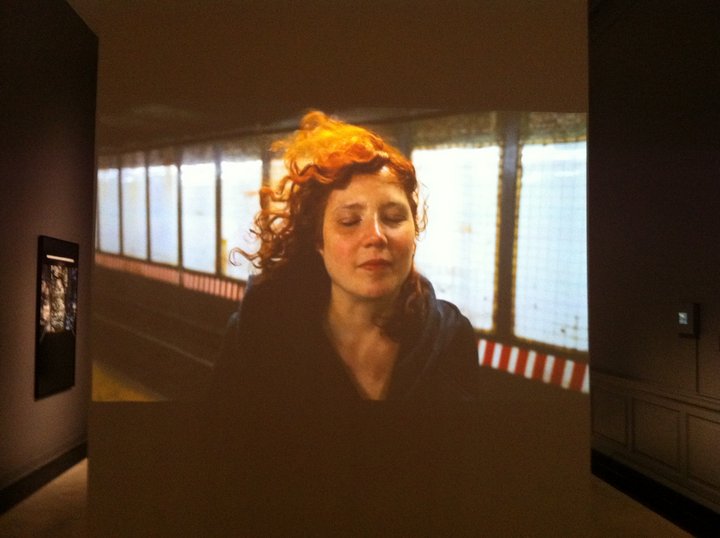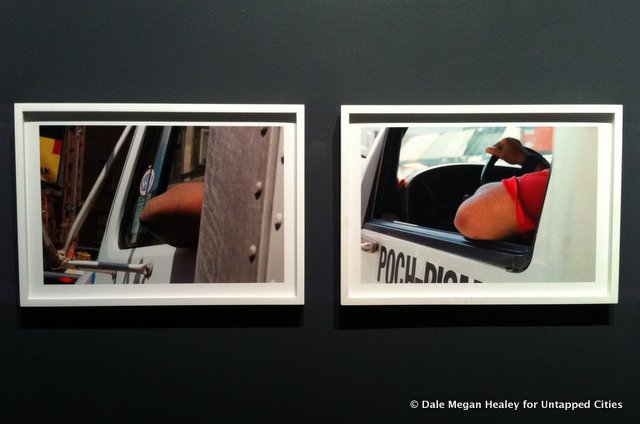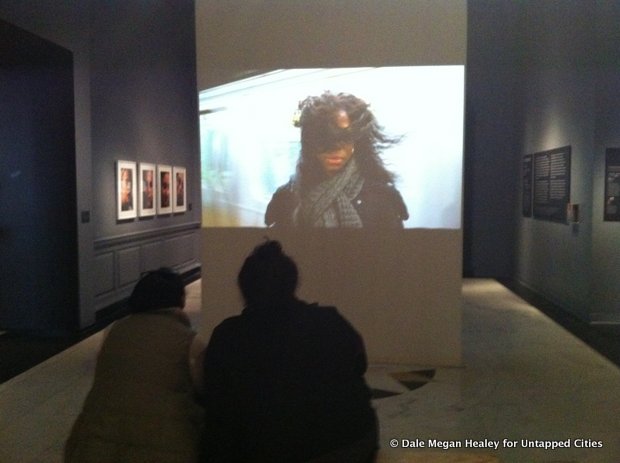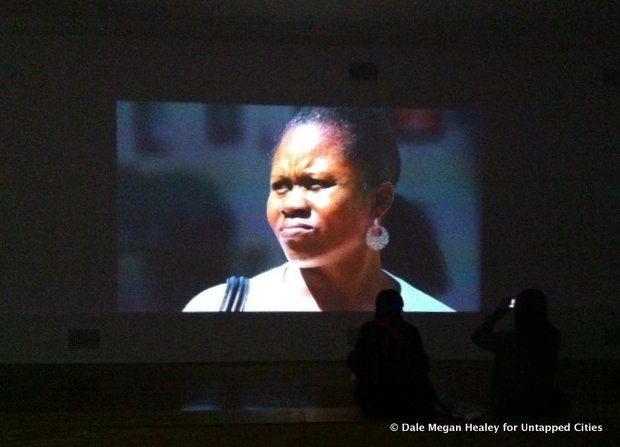 Neil Goldberg’s video installation, “Wind Tunnel.”
Neil Goldberg’s video installation, “Wind Tunnel.”
If you’re a New Yorker, walking through Neil Goldberg’s retrospective at The Museum of the City of New York is like walking through a collection of moments from your own day. Stories the City Tells Itself (now extended through June 19th) examines seemingly unremarkable urban moments that suddenly become worthy of our attention because, as city dwellers, we all share them. One installation features video of shop keepers raising their shutters in the morning, next to video of elderly passengers boarding the M15 bus. They pull themselves up, and the film captures both resilience and decrepitude as their ascension synchronizes with the rhythm of the opening shutters. There are film stills of disappointed passengers as they’ve just missed their train; silent footage of roller coaster riders trying to describe the Cyclone at Coney Island; close-ups of hungry salad bar patrons at lunch hour. These pieces demonstrate the varied ways New Yorkers encounter the same situation, with some appearing eerily identical.
In 1993 Goldberg shot video footage of eighty gay men from all five boroughs stroking their pet cats and saying, “She’s a talker.” I watched museum patrons giggle when they stood in front of the film, but amidst the lightheartedness, there’s a latent grief between frames. “Though the premise is unabashedly campy, the work was created at a time when many people around me were dying,” he says in an artist’s statement. “And that pervasive experience of mortality drove my wish to preserve these men on videotape.” I’ve only lived in New York for two years, but in a way, Goldberg’s work embodies exactly how I feel about this city. Some days I still find myself only delighted by, or horrified by my new home, with little range of emotions in between. Stories the City Tells Itself captures the feeling that underneath fun or silly New York peculiarities, we can often find signs of loss.
 Goldberg’s “Truck Drivers’ Elbows.”
Goldberg’s “Truck Drivers’ Elbows.”
Over the course of several weeks in 2005, Goldberg took portraits of truck driver’s elbows when he was stopped next to them on his bike. Each elbow takes on its own personality. The different birthmarks, scars, and skin colors become as evocative as facial expressions. The piece captures an everyday image, but I can’t help feeling as if it’s also a little sinister. One by one, the elbows begin to resemble severed but living limbs; disembodied flesh that hangs limply over the side of the large, sharp metal doors.
When I first moved here, I went through a phase of intense adoration for the energy of the city, especially the subway. I spent most of my adult life in San Francisco and grew up in Los Angeles, so I’m used to life in a city, but a Los Angeles commute is completely different from a New York commute. Here, I was excited to see us all piled into a train car together, rather than divided into our compact sedans and SUV’s as if we’re flying around the freeway in separate little houses. Here, the woman in head to toe Prada sits only a few feet away from the homeless man carrying all of his possessions in a garbage bag. I was thrilled by the musicians who would interrupt my reading on a morning commute. I stared at the art and wondered if everyone else loved it as much as I did. I went out every night not wanting to miss a thing. I was high on the city and then I crashed, with hardly any middle, level headed emotions in between.
The piece that moved me the most in Goldberg’s show was Wind Tunnel, in which he filmed blasts of air that blew through a rider’s hair as the train approached behind them in the Bedford L station. Each rider stares into the camera with her back to the train, slightly flinching as the climate changes. The footage is slowed down and silent. It’s a relief to watch the bumbling monster of a train hurdle through the frame without sound, the only consequence being the soft movement of a woman’s curls. Hair lashes around ecstatically, with violence as well as serenity; in step with the growing suspense of an approaching train. As I watched, I relaxed in the caring expression on each woman’s face and thought, This is exactly what I need.
 Visitors of The City Museum of New York watch “Wind Tunnel.”
Visitors of The City Museum of New York watch “Wind Tunnel.”
My New-York-grade anxiety began one summer night when I was on my way to an art opening on the roof of some tall building. I had only lived here for about a month, so maybe it was homesickness that made me so uneasy that night. Maybe it was the oppressive heat, or the smells in the subway station, or the man with acid burns where his face used to be who was walking through the train car asking for money. When I arrived at the top floor and looked at the view I was hardly struck by its beauty, but by its violence. The architecture surrounding us looked harsh, rather than elegant, with jagged angles of metal and glass. I pictured the man in the train and thought, that is what this city does to a body. The words that came to mind were; sharp, shatter, fall, burn. In the following days, I started to feel increasingly agoraphobic. Crowds of people felt disgustingly inhuman, along with the environment. My body was its own city and New York was foreign and dangerous, made up of a substance completely different than that of myself. The thought crept up on me that by living here, my body was at risk of being cut, destroyed.
Things got better for the next year and a half, but my anxiety reached another peak a few months ago. Since January, three people have died off of stops along my morning L train commute. Of course, my agoraphobia intensified, for me as well as many other straphangers in my neighborhood. The first two deaths happened in only one weekend. On that following Monday, I extended my commute and transferred at a different station. I was getting too good at looking around and imagining where exactly the violence had happened. Where on the tracks was he hit? Could any of those brown spots on the off-white tile wall be a drop of blood that emergency maintenance crews overlooked? Could a stretcher have carried someone along this very spot where I just put my foot? If I felt the yellow bumps that signified I was getting too close to the edge, I recoiled, as if stepping on something hot. I felt my pulse quicken as trains came near. I wondered what would happen if heart monitors measured the pulses of passengers waiting for a coming train. Doesn’t everyone’s pulse quicken when the huge metal beast races to a sudden, screeching halt only inches away from our faces?
I went back to my regular routine a few days later. It’s easy to act like nothing has happened when everyone else is acting like that too. The first thing that struck me was that there were no shrines””no flowers, photos, candles””nothing to indicate that a tragedy had very recently occupied this public space. Everyone looked the same, walking, hurrying as usual. I spoke to a representative from the MTA who told me that a loved one of the deceased would have to get special permission to put out flowers or pictures, and they’d probably be denied. The subway is too crowded for extra objects on the platform. It would be a safety issue.
I was on my way home on a Friday night in late March when, passing the Bedford station without stopping, the conductor came on the intercom to tell us that due to a police investigation, the next stop would be the last and we would have to transfer to a shuttle bus. A fight between two men had spilled onto the tracks right as the Manhattan bound L train was approaching. One man had escaped, and the other was pinned and killed while trying to climb back onto the platform. Hundreds of witnesses saw his body spin along the side of the platform as the train slowed. Witnesses said he was still breathing and moving his arms against the metal walls of the train after it had stopped. I read that the conductor told the passengers to get away from the windows, yelling, “You don’t want to see this.”
I avoided the Bedford Avenue stop for a week, but police sketches of the man who fled from the fight were plastered in every nearby station. The case was being treated as a homicide. The sketch of the man looked like an evil villain, too ugly and disheveled to be real. I tried not to look at the posters but when I looked at the ground in front of me, I again imagined drops of blood. I remember feeling relieved to hear the musician in the tunnel from the L to the 1-2-3, who sings the same annoyingly cheerful Beatles songs over and over again. I welcomed the innocence of his rendition of “I Wanna Hold Your Hand.” The next time I found myself at the Bedford L stop, I felt tears welling up when I heard the train approaching.
In Los Angeles, if you drive past a car accident, you are much more distant from the trauma. It is as if you are inside of a separate room; your own protective metal box, and whatever you witness is through a window. You will never walk over the ground where a person died on a freeway, because no one walks on a freeway. You zoom past the grave in your car. Perhaps you remember that you saw something there once, but by the time you can even begin to recreate the scene in your head, you’re too far away to notice any resemblances that the landscape in front of you has with the picture of the tragedy in your memory.
I wonder if seeing a shrine or flowers commemorating the spot where this man died would have made me feel better or worse. I didn’t know him, but it was a familiar place and I know that the energy in a space is altered when trauma and violence occupy it for a moment. Whenever I’m in Los Angeles, I feel a heaviness behind my eyes and my heart quickens when I drive by the UCLA Medical Center where someone close to me died. How many others regard the same hospital as a place of significance, a place that has been forever changed because of a tragedy that happened there? The subjects in Wind Tunnel look solemnly at the camera, and to me, they look like they could be mourning. They’re standing in the same spot where I tried not to look for blood on the ground, grieving for a space that has been changed.
 Goldberg’s video installation, “Surfacing.”
Goldberg’s video installation, “Surfacing.”
Behind the Wind Tunnel screen is Goldberg’s next piece, Subway Trapezoids which are photographs taken from the bottom of stairs leading out of subway stations. The grimy walls and gray stairs are a frame around the sky, or the trees, or the buildings above. The trapezoid shape resembles a coffin, with stairs leading out of it into a world of light and air. In Surfacing, Goldberg filmed the faces of bewildered passengers as they emerged from a station, blinking in the sudden daylight. Again the film appears as a choreographed dance, each person looks immediately disoriented, and then relieved when they recognize a familiar street and orient themselves in the direction they will follow. Each piece in Stories the City Tells Itself recognizes the complexity of being alive in a body in a particular place in time. It acts as a shrine for mourning the way we lose ourselves in a city, and it’s strangely healing. I left the exhibit feeling reoriented and comfortable in my home. I felt alive and whole in a body among other bodies here, as if the workings of New York City are not so separate from the workings of myself.
I’m projecting, of course, but situations as neutral and blank as a salad bar or a train station stairwell become available for thoughtful projections, especially when Goldberg rests his eyes on them. “Usually something I’ve half noticed countless times will for some reason start to distinguish itself,” Goldberg said in an interview with the show’s creator, Sean Corcoran. “Only later do I realize that there might be some connection between the specific moment I’ve selected and what’s going on in my life. For instance, I became interested in people orienting themselves as they emerge from the subway about a year after my father died. As I worked with the footage, I realized that what I was seeing on their faces somehow connected with the grief and disorientation I was experiencing just then. They have a look of vulnerability, tenuousness, searching. This wasn’t something I was conscious of when I started the project, but it’s there. This is not to say the project is about grief. The footage will hopefully mean different things to different people.” In my eyes, the work is about communal and unspoken grief. We give significance to a place by looking at it, not just by marking it with violence. It’s a relief to carefully celebrate the familiar places we might have otherwise failed to notice.
Museum of the City of NY
1220 Fifth Avenue
New York, NY 10029
Follow Untapped Cities on Twitter and Facebook.





